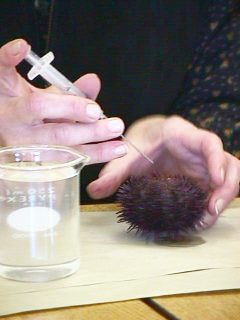Spawning a Sea Urchin

Only the Teacher should do the actual injection. A milliliter of 3.7% potassium chloride is injected into each side of the sea urchin. (Smaller amounts for smaller sea urchins. A Lytichinus pictus would only need a tenth of a milliliter per side.)
Smaller gauge, 25-30, needles work best.
Smaller gauge, 25-30, needles work best.

Notice how the needle goes into the soft part between the teeth and shell, on the opposite side from the syringe. This "squirts" the potassium chloride onto the gonads causing them to contract and expel the gametes.


Turn the sea urchin over (topside up now) and watch closely. Within about a minute (can take up to several minutes), gametes will start to show.


Orange indicates a female in most species (can be redish in others). Invert the sea urchin over a beaker of seawater and fill to the rim with seawater by pouring seawater over the sea urchin. Let the eggs drop to the bottom of the beaker.
Eggs should be used that class period unless you have used one of the special techniques to preserve them longer.

Female S. purpuratus
Males can be collected "dry" by sucking up the sperm from the top of the sea urchin (white) with a pipette and collecting the sperm into a small centrifuge tube or test tube. Sperm may be stored at 4°C in a refrigerator for up to a week.


